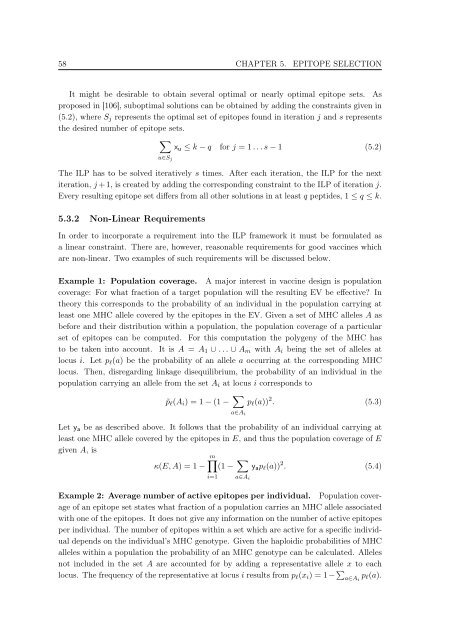New Approaches to in silico Design of Epitope-Based Vaccines
New Approaches to in silico Design of Epitope-Based Vaccines
New Approaches to in silico Design of Epitope-Based Vaccines
You also want an ePaper? Increase the reach of your titles
YUMPU automatically turns print PDFs into web optimized ePapers that Google loves.
58 CHAPTER 5. EPITOPE SELECTION<br />
It might be desirable <strong>to</strong> obta<strong>in</strong> several optimal or nearly optimal epi<strong>to</strong>pe sets. As<br />
proposed <strong>in</strong> [106], suboptimal solutions can be obta<strong>in</strong>ed by add<strong>in</strong>g the constra<strong>in</strong>ts given <strong>in</strong><br />
(5.2), where Sj represents the optimal set <strong>of</strong> epi<strong>to</strong>pes found <strong>in</strong> iteration j and s represents<br />
the desired number <strong>of</strong> epi<strong>to</strong>pe sets.<br />
<br />
xu ≤ k − q for j = 1 . . . s − 1 (5.2)<br />
u∈Sj<br />
The ILP has <strong>to</strong> be solved iteratively s times. After each iteration, the ILP for the next<br />
iteration, j + 1, is created by add<strong>in</strong>g the correspond<strong>in</strong>g constra<strong>in</strong>t <strong>to</strong> the ILP <strong>of</strong> iteration j.<br />
Every result<strong>in</strong>g epi<strong>to</strong>pe set differs from all other solutions <strong>in</strong> at least q peptides, 1 ≤ q ≤ k.<br />
5.3.2 Non-L<strong>in</strong>ear Requirements<br />
In order <strong>to</strong> <strong>in</strong>corporate a requirement <strong>in</strong><strong>to</strong> the ILP framework it must be formulated as<br />
a l<strong>in</strong>ear constra<strong>in</strong>t. There are, however, reasonable requirements for good vacc<strong>in</strong>es which<br />
are non-l<strong>in</strong>ear. Two examples <strong>of</strong> such requirements will be discussed below.<br />
Example 1: Population coverage. A major <strong>in</strong>terest <strong>in</strong> vacc<strong>in</strong>e design is population<br />
coverage: For what fraction <strong>of</strong> a target population will the result<strong>in</strong>g EV be effective? In<br />
theory this corresponds <strong>to</strong> the probability <strong>of</strong> an <strong>in</strong>dividual <strong>in</strong> the population carry<strong>in</strong>g at<br />
least one MHC allele covered by the epi<strong>to</strong>pes <strong>in</strong> the EV. Given a set <strong>of</strong> MHC alleles A as<br />
before and their distribution with<strong>in</strong> a population, the population coverage <strong>of</strong> a particular<br />
set <strong>of</strong> epi<strong>to</strong>pes can be computed. For this computation the polygeny <strong>of</strong> the MHC has<br />
<strong>to</strong> be taken <strong>in</strong><strong>to</strong> account. It is A = A1 ∪ . . . ∪ Am with Ai be<strong>in</strong>g the set <strong>of</strong> alleles at<br />
locus i. Let pℓ(a) be the probability <strong>of</strong> an allele a occurr<strong>in</strong>g at the correspond<strong>in</strong>g MHC<br />
locus. Then, disregard<strong>in</strong>g l<strong>in</strong>kage disequilibrium, the probability <strong>of</strong> an <strong>in</strong>dividual <strong>in</strong> the<br />
population carry<strong>in</strong>g an allele from the set Ai at locus i corresponds <strong>to</strong><br />
˜pℓ(Ai) = 1 − (1 − <br />
pℓ(a)) 2 . (5.3)<br />
Let ya be as described above. It follows that the probability <strong>of</strong> an <strong>in</strong>dividual carry<strong>in</strong>g at<br />
least one MHC allele covered by the epi<strong>to</strong>pes <strong>in</strong> E, and thus the population coverage <strong>of</strong> E<br />
given A, is<br />
m<br />
κ(E, A) = 1 − (1 − <br />
yapℓ(a)) 2 . (5.4)<br />
i=1<br />
Example 2: Average number <strong>of</strong> active epi<strong>to</strong>pes per <strong>in</strong>dividual. Population coverage<br />
<strong>of</strong> an epi<strong>to</strong>pe set states what fraction <strong>of</strong> a population carries an MHC allele associated<br />
with one <strong>of</strong> the epi<strong>to</strong>pes. It does not give any <strong>in</strong>formation on the number <strong>of</strong> active epi<strong>to</strong>pes<br />
per <strong>in</strong>dividual. The number <strong>of</strong> epi<strong>to</strong>pes with<strong>in</strong> a set which are active for a specific <strong>in</strong>dividual<br />
depends on the <strong>in</strong>dividual’s MHC genotype. Given the haploidic probabilities <strong>of</strong> MHC<br />
alleles with<strong>in</strong> a population the probability <strong>of</strong> an MHC genotype can be calculated. Alleles<br />
not <strong>in</strong>cluded <strong>in</strong> the set A are accounted for by add<strong>in</strong>g a representative allele x <strong>to</strong> each<br />
locus. The frequency <strong>of</strong> the representative at locus i results from pℓ(xi) = 1− <br />
a∈Ai pℓ(a).<br />
a∈Ai<br />
a∈Ai

















